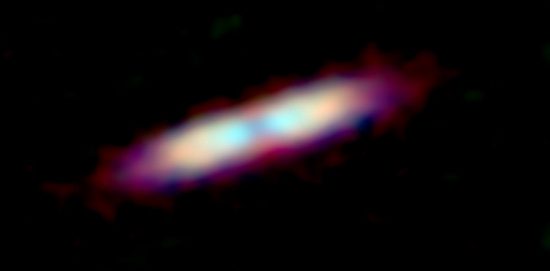
Dec 27, 2019
Disks around stars indicate electromagnetic induction.
A recent press release from the National Astronomical Observatory of Japan reports “…a young star surrounded by an astonishing mass of gas.” As usual, astronomers involved with the investigation report that the “…enigmatically large amount of gas requests a reconsideration of our current understanding of planet formation.”
According to the Nebular Hypothesis, when a star forms it “condenses” out of primordial gas and dust. Whatever material that is not absorbed swirls around, attracting more particles, until it also condenses, but this time into planets.
The edge-on ring surrounding 49 Ceti is orbiting the star. It is there that the Atacama Large Millimeter/submillimeter Array (ALMA) telescope in Chile found a high concentration of CO gas. Since the ultraviolet light from 49 Ceti should cause the gas to dissociate, and not leave 10 times the amount of gas and dust expected in planet-forming models, astronomers are puzzled.
Star formation is conventionally associated with high frequency light—extreme ultraviolet shines from “cosmic eggs”. One of the most iconic images in modern astrophotography is the famous “Pillars of Creation” in the Eagle Nebula, although the vast majority of proplyds are found in the Orion Molecular Cloud and the Carina Nebula.
As written previously, the Electric Star theory resolves the distorted opinions that arise from misunderstanding the role of plasma and electric fields in space. Rather than hot gas, the radiant emanations from 49 Ceti are due to electric currents.
Electric discharges in a plasma cloud create double layers, or sheaths, along the current axis. Positive charge builds up on one side and negative charge on the other. An electric field develops between the sides, and if enough current is applied the sheath glows, otherwise it is invisible. Electric currents flow along the sheaths. In plasma, the currents spiral into filaments. The filaments attract each other, but rather than merging they spiral around, gradually pinching down into arc mode discharges.
It is in this way that stars are born. Gravity, although it plays a small role in stellar evolution, is far too weak a force when compared to an electric field and ionized particles. The concentration of CO gas from 59 Ceti is not the result of cold cometary clumps colliding. It is because carbon and oxygen are common in nebulae (and proplyds). The disks surrounding stars are not due to gravitational accretion, they are due to electromagnetic expulsion.
In an Electric Universe, dust and gas (and planets) ought to be found around other stars. Stars “give birth” electrically from their charged interiors. Since stars are not powered by hydrogen fusion but by incoming electric currents, whatever fusion does take place is most likely taking place close to or on the surface. There is no super-compressed, intensely hot core, radiating energy from thousands of kilometers deep inside. Instead, heavy elements are synthesized in the exterior plasma discharges and then “precipitate” into the star’s interior like a rain of metal atoms.
By that same token, since 90% of the light from nebulae exhibits the wavelength of ionized oxygen, it is not surprising that concentrations of CO can be found around hot, bright stars. Electric forces acting on a star might offset its internal positive charge. If that happens, the positive charges will repel each other and accelerate away from the center of the star, resulting in an expulsion disk composed of the star’s ionized interior.
Stephen Smith
The Thunderbolts Picture of the Day is generously supported by the Mainwaring Archive Foundation.












